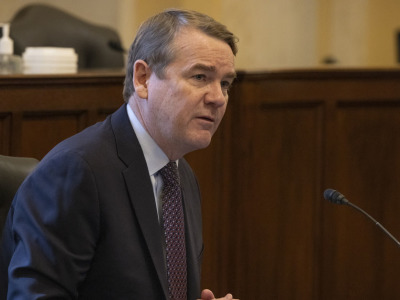With drought increasing across the west and fire season already underway, senators are gathering suggestions about what more the federal government can do.
The Senate Energy and Natural Resources Committee heard from Forest Service Chief Randy Moore last week on how his agency’s proposed budget will address drought and wildfire, and an agriculture subcommittee took testimony from Midwest and western water managers and users.
“Unfortunately, this year it seems to be shaping up to be another difficult fire season,” Sen. John Barrasso, R-Wyo., said. “Severe drought and a lack of proactive management have turned many of our landscapes into tinderboxes.”
A major New Mexico fire began as a prescribed burn, which Moore said is a management tool the agency has used successfully “in nearly all cases across the country.” Still, he called for a 90-day halt on prescribed burns to evaluate what went wrong. (He noted 90% of planned burns for this year were already completed.) Areas of forest that have not been adequately thinned through prescribed burns or timber harvest, the chief noted, present a higher risk for fires spreading widely across parched landscapes.
“A lot of times when fires hit those kinds of conditions, it’s really exploding into catastrophic fire,” Moore said.
“These fires are not your grandfather's fires — they're bigger, they're hotter, they're more powerful,” Sen. Ron Wyden, D-Ore., said.
 Forest Service Chief Randy Moore
Wyden and other senators pressed Moore to do more thinning and to sell more timber. Moore committed to ongoing relationships with the timber industry saying, "I've said from the very beginning, and I'll say it to my death, that without industry, we will not be able to manage the forests.”
Forest Service Chief Randy Moore
Wyden and other senators pressed Moore to do more thinning and to sell more timber. Moore committed to ongoing relationships with the timber industry saying, "I've said from the very beginning, and I'll say it to my death, that without industry, we will not be able to manage the forests.”The Forest Service is implementing a 10-year plan to create more resilient forests, in part through fuel reduction, and Moore said the work will be done in more targeted locations than in the past. Before, he said, the approach was “almost like spreading peanut butter” where “everyone gets a little bit.” But Moore explained that approach means nobody gets enough.
Now, the Forest Service has defined “fire sheds” of about 250,000 acres and has chosen the most urgent 10 to start with. This way, treatments should be robust enough to create “the conditions that we need out in the landscape,” he said. Moore credited the Great American Outdoors Act and the new infrastructure law for helping fund the necessary work.
Next year’s farm bill negotiations could be the next place where forest management’s role in fire prevention, drought mitigation and water management gets some attention. At the Senate Ag “Western Water Crisis” hearing, subcommittee chair Sen. Michael Bennet, D-Colo., said his goal was to raise alarm bells. “These conditions threaten to put farmers and ranchers out of business,” he said. “And frankly, threatens our way of life in the West.”
Sen. Roger Marshall, R-Kan., said his state could lose as much as 30% of its average wheat yield this year. “That's a value of over a billion dollars to the state of Kansas.” And a farmer from western Kansas testified that the state is doing more to help him adapt than USDA programs. Tom Willis said his farm got an inch of rain recently — the first his fields received since August. But with sorghum in his crop rotation and technology that manages every drop of water, he’s been able to save 1.2 billion gallons (8,887 acre feet) of water over the past six years.
“I do use state programs. I get asked sometimes ‘why don't you use the federal programs?’ The reality of it is, the state is simple,” he said. “Depending on what the year brings, I can be very flexible. Unfortunately, with the federal programs, they mean well but the flexibility is not there.” In the next farm bill, he urged senators to “remember one size does not fit all. And the key to getting farmer adaptation to all this is flexibility.”
Looking for the best, most comprehensive and balanced news source in agriculture? Our Agri-Pulse editors don't miss a beat! Sign up for a free month-long subscription.
Other witnesses agreed more flexibility in the farm bill, even in programs that have enjoyed some success, would help.
 Sen. Michael Bennet, D-Colo (Photo: Joy Philippi)
Sen. Michael Bennet, D-Colo (Photo: Joy Philippi)
“Programs such as (the Environmental Quality Incentives Program), the Regional Conservation Partnership Program and Conservation Reserve Enhancement Program are all programs which implement best management practices,” Earl Lewis, chief engineer at the Western States Water Council, said, but he also pointed out the application process can be overwhelming.
“We would love to see a farm bill that directs the (Natural Resources Conservation Service) to be able to use the US Bureau of Reclamation (National Environmental Policy Act) compliance program” to speed things up, he said.
“We see potential for augmenting funding for climate adaptation research and possibly for more land grant-USDA climate hub partnerships” in the next farm bill, said Courtney Schultz, a professor of forest and natural resource policy at Colorado State University.
“The situation will only get worse,” she added, “and it's far more expensive to respond reactively than it is to work proactively.”
Andy Mueller, general manager of the Colorado River Water Conservation District, said another federal investment that would have wide-reaching impacts would be “strategically placed small reservoirs in our high mountain valleys.” That small-scale infrastructure, he said, would “mitigate climate change by retiming the flows, which will provide essential water for our streams, our communities and our food supply.”
Lewis also raised the concern of post-fire recovery. He said he’s looking into what people need and what challenges they run up against. “And I think that would be an area for emphasis for the farm bill,” he said.
For more news, go to www.Agri-Pulse.com.

